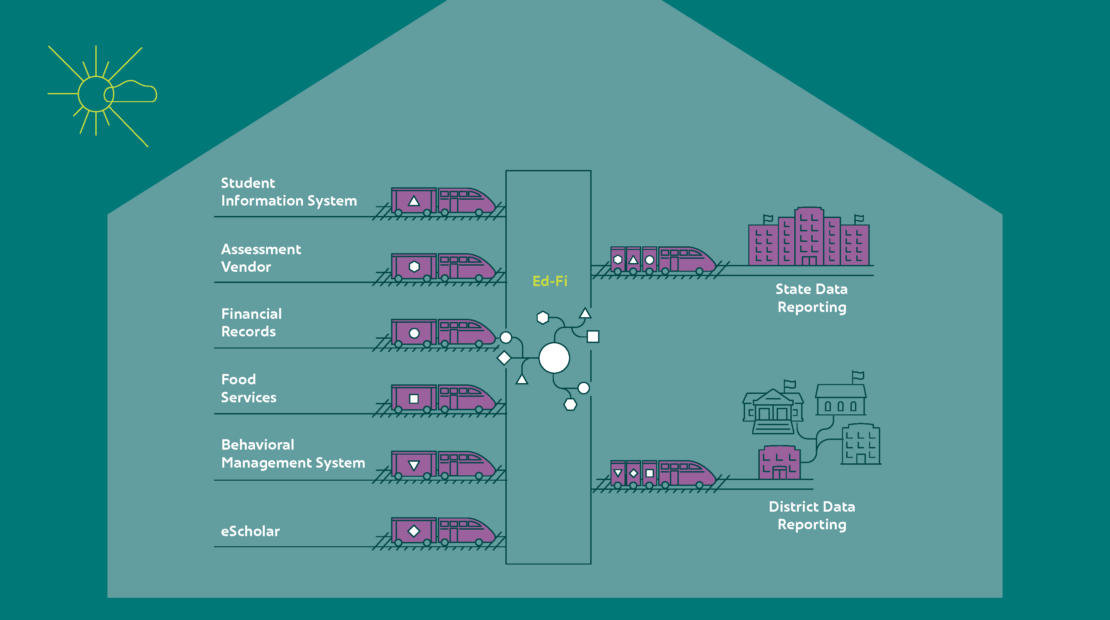At Education Analytics (EA), we’re motivated to share the advantages of Ed-Fi, a set of rules and standards that allow previously disconnected educational data systems to connect. We’ve seen the advantages in education when we can connect data systems, like assessment platforms, rostering tools, instructional programs, and more. This blog provides a review of key terms related to Ed-Fi, for both newcomers starting their Ed-Fi journey to experts familiar with this field. Understanding these five vocabulary words — Interoperability, Education Agency, Source System, Student Information System, and Data Warehouse — will enable education agencies and those involved in the education sphere in general to familiarize themselves with the core concepts to help enable progress in the Ed-Fi implementation process within their agency, school, district, or state.
1. Interoperability: Technology that allows for data to be formatted and exchanged between different systems. Often, interoperability is thought about as a mechanism that enables the storage or reporting of data from different systems. We can see this depicted in the illustration below, where Ed-Fi serves as the interoperable layer that facilitates data movement from source systems to reporting tool or platform.
Interoperability serves as both a reporting and transporting mechanism – meaning that interoperability is about getting data to the right place for use in other places and getting data into the right place to be able to report it all in one place.
Interoperability is about getting data into the right place, at the right time, with the right amount of supporting information to make it meaningful and useful. Interoperability is, at its core, about enabling the broader and more coherent use of data.
State education agencies, or SEAs, and local education agencies, or LEAs, located in South Carolina, Michigan, Colorado, Wisconsin, Texas, Arizona, Delaware, and Georgia are well on their way to making interoperability a reality for their schools and districts. For these partners, the interoperability technology of choice is Ed-Fi.
For example, interoperability means that in the future, instead of relying only on data collected in manual and labor-intensive ways, researchers will be able to tap into the power of real-time operational data – what we refer to as moving from datasets to data streams.
Interoperable data streams will allow education agencies access to cross-domain data in ways that are much faster, easier, and less costly. This means exponentially less time gathering, combining, and understanding the nuance of local data and providing more time for agencies to analyze and interpret this data.
2. Education Agency
a. LEA (Local Education Agency): A public authority responsible for the operation of local schools and educational programs.
b. SEA (State Education Agency): A state-level governmental organization responsible for overseeing and implementing education policies and programs within a state.
In a local education agency like a district, Ed-Fi connects data from different places (across schools) and different times (across school years), and working with a partner like EA, produces student-level granular metrics from these different data elements – things like graduation rates and attendance rates. Ed-Fi can support essential data elements that are often missing, like descriptions of the spaces where and times when those data were generated, collected, or gathered.
The model above demonstrates how LEAs always maintain control over their data through the combined use of EA’s secure data ecosystem and Ed-Fi. When LEAs utilize a product like StartingBlocks, they can bring together data from learning management systems (LMS), student information systems (SIS), and human resources information system (HRIS), to enable them to make data-driven decision making faster and easier. The data can then be stored in a secure data warehouse like Stadium, for analytics before having that data visualized in Podium, EA’s set of standard visualizations. This allows LEA staff can see the analytics they need to help students in their district or state.
Looking towards the future state of national educational data infrastructure, we envision a live, fully integrated operational data store (ODS) within each local education agency. Each ODS would capture transactional from all the LEA’s operational systems, including the student information system, enterprise resource planning system, human resources information system, transportation system, learning management system, nutrition system, and more. To enable this, almost all vendors of the various education technology systems need to integrate with standards-based interoperability tools. All these tools can “talk” to each other using Ed-Fi ODS (technology managed by the Ed-Fi Alliance) - at the discretion of the LEA’s governance structure.
3. Source System
There are a numerous data systems that any given LEA needs to use, including Human Resources Information Systems (HRIS) or Enterprise Resource Planning (ERP) systems, Student Information Systems (SIS), survey platforms, professional development systems, and learning object repositories.
A standard dataset that would pull these data together would require a district staff member to manage different systems and then merge the data in a logical and error-free process. Within one district, this would be a complex, time-consuming and costly task as it would require a person to complete a multi-step process for each individual source system. A previous blog blog on our website describes this process and highlights the advantages of integrating modern technology and educational research to improve student outcomes.
Interoperability seeks to address this tedious process of collecting data from individual source systems by enabling each system to “talk” to each other. Ed-Fi is the interoperable tool that allows data to be passed between each system into a reporting tool or platform, which then provides education agencies with the most useful data in the most secure, private and efficient manner. Interoperability is the solution these agencies need to access the right data at the right time to ensure improvement in learning outcomes for all the students they serve.
4. SIS Student Information System (SIS): A software application that manages student data, including demographics, attendance, grades, and other relevant information. There are many different SIS vendors who provide these systems to LEAs and SEAs.
Student data are typically entered by school staff on behalf of students in the tools that the districts select, such as student information systems and gradebooks. It is essential to protect this student data with the highest standards of protection and integrity.
Student information systems often house data like daily disciplinary records, period-by-period attendance, student-teacher links, and student-school links, and most researchers aspire to have access to these kinds of fine-grained operational data – if they know how to ask for it. Currently, researchers rely on “dead” (out of date) data extracted from the SIS at a typically slow cadence (annually or perhaps twice a year). Interoperable ecosystems that utilize Ed-Fi technology can provide researchers with live (up to date) data that is captured in systems like student information systems. Having access to this live data enables districts to put that research and data to immediate use and answer their research question across a much larger dataset more quickly, accurately, and at a lower cost.
For analytics projects at EA, we collect data elements like student demographic information, assessment scores, attendance data, and social emotional learning (SEL) survey data, which we typically receive from multiple sources, such as state departments of education, school districts, assessment vendors, and student information systems. EA has operationalized Ed-Fi to assist in research and analytics projects like measuring classroom support for SEL or studying the stability of school contributions to SEL gains.
5. Data Warehouse: A centralized repository where educational data from various sources, such as assessments and student information systems, are stored and can be accessed for analysis.
A data warehouse is a central repository for an organization's data, organized for analytics. Using interoperability standards for the collection of data makes the labor-intensive work of reconciling data originating in different source systems easier. However, interoperability standards are optimized for communication between machines, not for analytics and research.
Modern data warehouses are more than just places for the storage of data. They are platforms for applying computations, models, and business logic to an education agency's data. The Enable Data Union Framework published by Education Analytics is designed to provide an easy way to turn interoperable data into usable data for analytics and research.
For educators and administrators at various levels of the education system (school, district and state-level), pulling data together is time-consuming and often requires technical expertise. Administrators and educators increasingly need to be data experts, not just in interpreting data and leveraging their content expertise, but also in managing data. This is where EA’s data warehousing tool, Stadium, offers solutions. Stadium is a managed data warehousing service built on Ed-Fi and is an analytics solution for education agencies that have implemented Ed-Fi and now are ready to use the data in Ed-Fi for analytics, research, and data visualization. Stadium received the 2022 Ed-Fi Summit Solution of the Year award for its contributions to the Ed-Fi space. Podium, Education Analytics’ set of standard visualizations that makes data generated by schools and school districts easier to understand, can seamlessly sit on top of Stadium to visualize and report data stored in the data warehouse.
As Ed-Fi evolves, so does the shared vocabulary. EA is excited to be part of this revolutionary journey that is making a difference in the lives of students. We look forward to when these five words are commonplace across the educational system and welcome an on-going conversation on how Ed-Fi is positively improving educational outcomes.
To dig deeper into the concepts and terminology discussed in this blog, check out the blogs and resources listed below:

